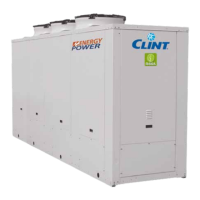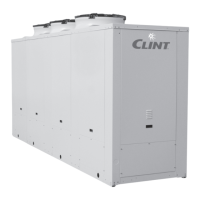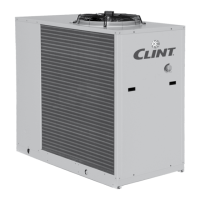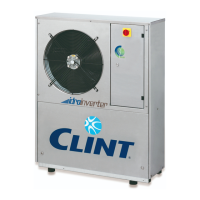
Do you have a question about the Clint CHA Series and is the answer not in the manual?
| Refrigerant | R134a |
|---|---|
| Compressor Type | Screw |
| Acoustic Insulation | Yes (on compressor) |
| Power Supply | 400V/3Ph/50Hz |
| Noise Level | Data not available |
| Weight | Data not available |
Provides general information about the manual, unit operation, and associated risks.
Lists documents considered an integral part of this manual.
Highlights unit design for reliability and safety, compliance, and user responsibilities.
Explains how to identify the unit using labels on the frame and electrical box.
Describes the unit's purpose: cooling water, with heat pump units also heating water.
Lists substances to avoid near the unit and conditions harmful to the environment.
Details the unit's construction: galvanized sheet metal, removable panels for maintenance.
Defines terms like dangerous areas, exposed persons, and operators/maintenance personnel.
Outlines prohibitions and essential safety rules for operating and maintaining the unit.
Explains the meaning of various safety signs and symbols used on the unit.
Details specific safety signs related to distances, electrical hazards, lifting, and hot surfaces.
Specifies the requirement for an external emergency circuit breaker for power disconnection.
Identifies potential dangers, main risks, exposed persons, and safety methods.
Lists risks like electrocution, cuts, noise, and refrigerant leaks near the unit.
Provides first aid and environmental precautions for refrigerant leaks.
Details safety precautions when working with panels removed, including power disconnection.
Instructs checking unit integrity upon receipt and reporting any damages to the forwarder.
Specifies the ambient temperature range for storing the units.
Details safe handling procedures, emphasizing proper lifting points and avoiding sudden movements.
Guides on how to unpack the unit carefully and dispose of packing materials responsibly.
Covers considerations like unit weight, supporting surface, space, noise, and prevailing winds.
Provides instructions for installing the chilled water circuit, including pipe support and component installation.
Details critical aspects of the evaporator connection, water flow, and capacity calculations.
Emphasizes that electrical connections must be done by specialized staff and ensure correct voltage.
Lists essential checks before starting the unit, including electrical connections and water circuit.
Explains how to select the operating cycle and start the unit, noting compressor and fan behavior.
Details checks for sounds, vibrations, refrigerant circuit status, and temperature parameters.
Describes the automatic defrosting process for heat pump units during winter operation.
Instructs on the correct procedure for stopping the unit using the OFF button.
Explains how to start and stop the unit via the microprocessor and how the unit handles faults.
Provides guidance on preparing the unit for long periods of inactivity, including draining fluid.
Lists common causes and recommended actions when the unit fails to start.
Covers scenarios where a compressor doesn't start, or starts/stops repeatedly.
Troubleshooting steps for when the unit's fans do not operate.
Diagnoses issues where compressor stops due to high or low pressure switch trips.
Addresses refrigerant leaks, hot fluid pipes, frost formation, and clogged filters.
Covers unit not stopping, insufficient output, defrost cycle failures, and abnormal noise.
Recommends periodic checks for correct operation and outlines monthly and four-monthly controls.
Details specific checks to be performed monthly, including electrical connections and refrigerant levels.
Lists checks to be performed every four months, focusing on fans, paint, and liquid indicator.
States that refrigerant circuit repairs must be done by specialized staff.
Provides instructions for refilling refrigerant, including limits on top-ups.
Guides on how to dispose of the unit at the end of its life, including refrigerant and oil collection.
Explains the unit's capability to produce both chilled and hot water on separate circuits.
Details how two microprocessors manage refrigerated and hot water circuits, compressors, and alarms.











